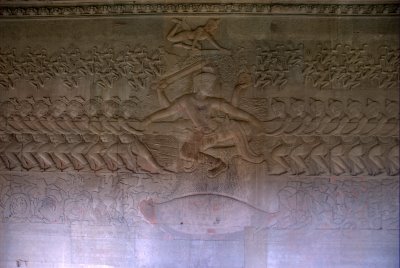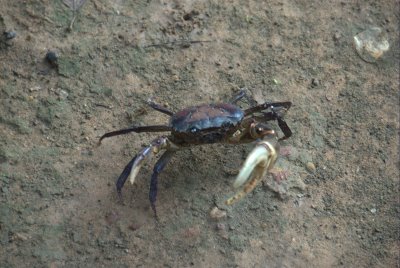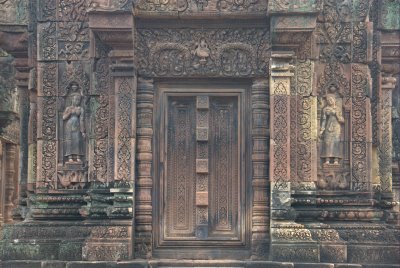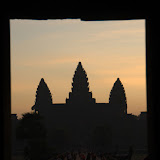 Means of Locomotion
Means of LocomotionIt's 4:30a in the morning when I sleepily climb into Ly's tuktuk. In Thailand and India, a tuktuk is a 3-wheeled, smog-spouting vehicle with the driver sitting up front and a wide, covered seat for passengers in the back. Here in Cambodia, the design has been improved on. Since the invention of the wheel, Man has been harnessing the power of non-wheeled things to pull carts, carriages and anything else that could carry things. From man to buffalo to horse, anything with the power to move has been hitched to a cart and told to pull.
In Cambodia, they took the idea to the next step. They've hitched the motorcycle. Ly's tuktuk is a small, run-of-the-mill motorcycle with the back seat converted to a harness. That harness is connected to a two-wheeled covered "wagon" with a large, almost regal, seat. This is a much more comfortable and much cleaner ride than the original tuktuk. For the princely some of $35, Ly is my personal driver for the next 3 days.
I climbed into the seat with my camera bag and off we went through the dark streets of Siem Reap. We weren't alone. Many other taxis, motorcycles and tuktuks where going the same route. We stopped for a few minutes to get me a ticket and off we were to our first site.

Artichoke City
Once we left Siem Reap, we traveled through a dark forest. The first glimpse of our target was a large river. The sky was starting to lighten and we could see its reflection in the water. Our river of traffic followed the real one, angling around a 90 degree bend and continuing on.
The sky is turning reddish-blue, promising a wonderful sunrise. The sun will rise from beyond the river, hence the sky is bright but the jungle across the river looks completely black. It looks like the Hollywood set for an old Tarzan movie. The black-silhouetted trees extending into the bright sky seems to be painted onto a huge canvas serving as the backdrop for a cannibal cooking feast scene.

I can see the palm trees sticking out of the canopy and being reflected in the river, some 200 meters (600 feet wide). As Ly keeps gunning the motor and the tourist stream keeps moving at a slow but steady pace, I suddenly notice some strange trees sticking out against the backdrop. Could these be huge artichokes? Artichokes?

Artichokes do not grow on trees nor reach this size. What can this be?
That's when it hit me. We've arrived. This is majestic Angkor Wat! And that river is no river - it's a moat surrounding all of Angkor Wat.

Angkor Background
Angkor Wat (Holy Temple) is only one of a staggering number of temples, palaces and structures in the Siem Reap area. Siem Reap means "Siam Defeated" even though the city was eventually conquered by the Thais. Today it is back in Cambodian hands and serves the tourist population that comes by to see Angkor.
Angkor Wat itself was built during the reign of Suryavarman II, 1112-1152. It sits a kilometer outside of Angkor Thom, the walled city of Angkor. While the temple is huge (1km by 800m or 0.5 mile by 0.6 mile), the city is even bigger. At 10 sq km, it contains a number of temples and palaces, as well as jungle and the ever-present rice fields where locals continue to grow their food to this day.
The structures in the Angkor area were built from 875 AD to 1230 AD by a succession of kings, at an unknown cost of human lives. The most common building material is red or black limestone that was quarried 40km away from the site then floated on barges down the river to the construction area.
You can see my Angkor Wat photo album at:
Mount Meru and Churned Milk
Cambodia at the time was a Hindu nation, transitioning into Buddhism. The king decided on the religion and the rest followed. The country flip-flopped a couple of times before finally settling on Buddhism as its main religion.
The construction of most of the temples reflected the Hindu mythology. Mount Meru, tallest mountain and home of the gods (does this sound like Olympus in any way?) served as the blueprint for the buildings. Mount Meru is surrounded by 4 lower mountains and by oceans. Angkor Wat is built with 4 towers surrounding a higher 5th. Artificial lakes and the moat surround the towers. Other buildings in the area follow the same plan.
The walls are decorated with endless bas-reliefs. Most are variations of celestial dancers.

The building of the Angkor Temple has stories carved into the walls all around it. This corridor, for example, talks about the king that built Angkor and of life in Cambodia at the time.

A story that repeats itself both in bas-relief and through statues in other structures is the Churning of the Sea of Milk. The gods and demons both sought after the elixir of mortality. In order to get it, they used the serpent Vasuki, the gods holding on to his head and the demons to his tail and pulled back and forth in order to churn the sea of milk. Out of the sea arose both the elixir (which the gods then nabbed and became immortal) but also the celestial dancers that abound all over the walls in Angkor.

The scene was recreated in statues at the entrance to Angkor Thom and Preah Kahn, another temple in the are.

Right next to the statues I found this fiddler crab that looked at me very suspiciously and turned wherever I went so that it could keep me in its sights.

Mount Meru is difficult to climb and the temple is built to reflect that. The stairs leading to the platform where the 5 towers seat look regular from far away.

Until you approach them and realize the steps are very high and very narrow. It's almost like climbing a ladder except some of the steps are broken so watch out.

The view from the top is nice though and definitely worth the climb.
Other Structures and Sights
As I mentioned, the area is vast with many temples and places, and two barrays. A barray is a huge, artificial body of water used both for political reasons as well as agricultural ones. The ones in Angkor are 2km x 8km wide.
Ta Phrom is the famous crumbled temple. While Angkor Wat was inhabited the entire time since it was built and thus relatively well preserved, Ta Phrom was abandoned. Birds flying over it dropped seeds that eventually grew into trees on top of the Ta Phrom structures. The site is the famous one from Tomb Raider II, where Angelina Jolie enters a long lost temple. Angelina seems to be as famous here as the temples, with tourist guides claiming they have pictures with her and showing you where the scenes were shot.

Other interesting sites include the mysterious smiling faces at the Bayon temple, looking down on you from on high.

There's also the Hindu temple delicately carved from red stone.


Bandolla
Near each site and sometimes even inside are locals selling drinks and souvenirs. The most common practice is to let kids, the littler the better, be the ones selling or at least the ones bringing you into the store. They are less resistible.
Walking around, I was approached by a small girl (probably 6-7) who tried to sell me a flute. She kept saying "you buy flute from me" and "only one dollar" and so one. She kept asking where I was from, trying to make conversation while I practiced my meditation mantra "no, no, no" without achieving enlightenment or even inner peace. Suddenly, a boy approached us from the other side. He too had flutes with him and held one up for me to see. I kept walking towards the temple I've come to see while the girl furiously whispered something to the boy in Cambodian. He didn't seem to get it though even I could understand the "go away I'm already selling to this bozo" instructions. The girl kept saying "one flute one dollar" at which point the boy said "two flutes, one dollar". I remained unconcerned - I can play on two flutes as well as I can on one - not at all. The girl, upping the ante, said "three flutes, one dollar" and the whole scene deteriorated into a price war.
Kids are also there to be adorable. I don't mean that in an existential way, I mean in the cold, calculating, hard cash way of the tourist paying to take a picture. In strategic locations around the sites you'll see cute kids sitting around doing nothing. As you approach, they'll jump into a pose and ask you if you want a picture. I saw a small kid hug his baby sister when I arrived, as well as another who held up a tiny puppy when she saw me approaching. These were way too artificial for my taste. The only one I shot was a candid of this girl who was sitting waiting for tourists to arrive.

Walking into one of the temples, a very small girl approached me. She was barely out of toddlerhood and was walking with that unstable amble of little kids. She held up a set of postcards and asked me something. I asked her what her name was to which she replied "Bandolla".
Bandolla? That didn't sound Cambodian.
"Bandolla?" I asked. She just looked at me, showed me the postcards again and said "One Dollar". I walked on.
Very Similar but not Quite
In Thailand, Cambodia and Vietnam, the phrase "Same-Same" seems to have been adopted by the locals when speaking to tourists. I'm not sure if it's a morphing of "the same" or how it came about but the usage is "is same same" when you want to say something is similar to something else.
For example "our tour is same-same other company" or "our rooms near the river, same-same other hotel", etc.
Of course having "same-same" in the language quickly leads to the creation of "but it's not exactly equivalent". The appropriate phrase - "same-same but different" can be found on T-shirts sold throughout the region.
Shooting it Out
Coming back to town on the second day, Ly asked me if I wanted to shoot a gun. We came up on an intersection where the sign pointed left to a dirt road and said "4th army regiment training ground". We took that turn and after a few minutes rough driving arrived at the shooting range "just next" to the army base.
You can choose your poison, from M-16s, AK-47 or older guns and shoot 35 bullets for $35. I declined. There was nothing there we didn't do at basic training.
The Last Artichoke
I started the second day early again, though this time I went to places where the tourists weren't. Walking between the faces of Bayon, seeing the elephant terrace and other palaces while the Sun is just starting its climb and sound of the jungle surround you is magical. Walking along the forest paths, you see tiny things jump away. I thought they were insects at first, but a closer examination showed they were tiny frogs, no bigger than the nail of my smallest finger. You can see the frog in this picture smack in the middle. Look how well it blends in with the color of the ground.

There are a few spots in Angkor famous for their sunset-ability. These are locations where everyone congregates to watch the sunset. One such was a hilltop temple near Angkor Thom. We arrived early so that I'd have time to climb it and catch a good place to sit. You can shell out $15 and be carried by an elephant to the top of the hill. I declined and took the path climbing up the hill. The path is not steep but it is long and takes a while to navigate. By this point in the trip I was in a better physical shape and took the whole hill in one go. I arrived huffing and puffing to the top where cresting the rise I was greeted by another one of those damn artichokes.
This one had a flat top and looked to be crawling with tourists.

I climbed the high and narrow stairs (you've got to work at getting to Mt. Meru) and at the top walked around trying to find a good vantage point. I was sorely disappointed. The trees all around the hill obscure a lot of the view and the landscape is nothing special.

Angkor Wat itself was too far and required the full magnification of my camera to catch a lame shot of it.
 I climbed down while the sun set, leaving the tourists hoards and the television crew on top of the temple to watch it go down. The following day I took myself to Angkor Wat, sat myself down on one of the surrounding buildings and took this time-lapse movie of the tourists leaving as the day ends on Angkor.
I climbed down while the sun set, leaving the tourists hoards and the television crew on top of the temple to watch it go down. The following day I took myself to Angkor Wat, sat myself down on one of the surrounding buildings and took this time-lapse movie of the tourists leaving as the day ends on Angkor.Technorati Tags: Cambodia, Angkor Wat, Artichoke, Tuktuk, Hinduism, Buddhism, Mt. Meru, Eran Davidov, Travel Blogs

No comments:
Post a Comment